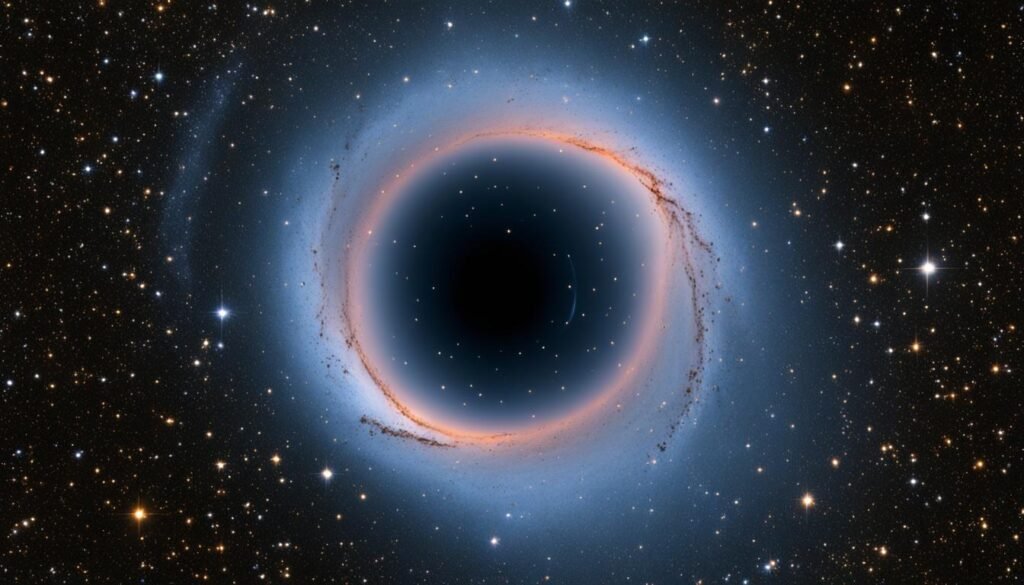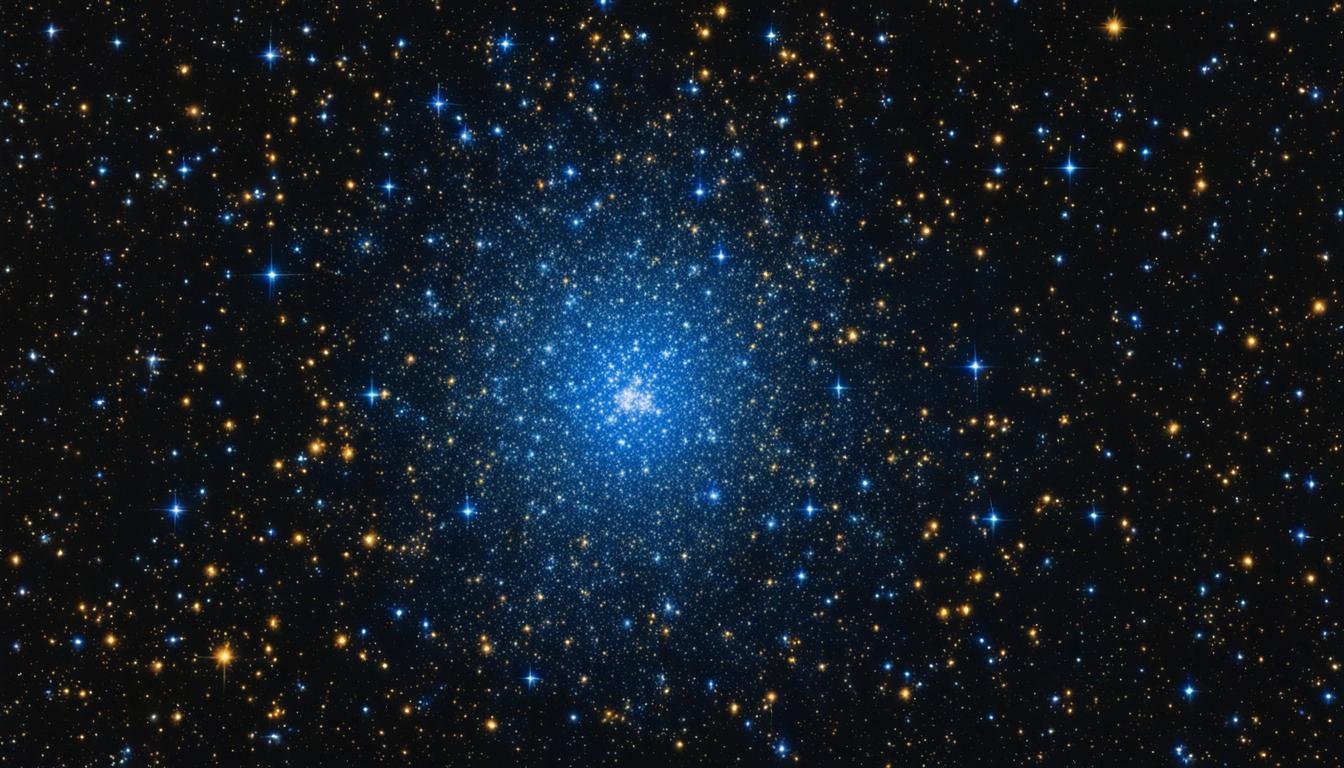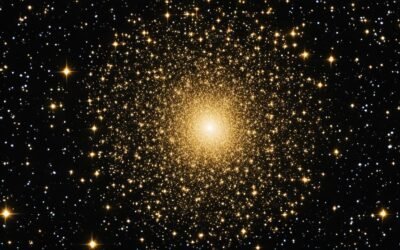Welcome to the fascinating world of Messier 15, also known as the Great Pegasus Cluster. Located in the constellation Pegasus, this captivating globular cluster has intrigued astronomers and stargazers for centuries. Let’s explore the key features and discoveries associated with Messier 15.
Key Takeaways:
- Messier 15, also known as the Great Pegasus Cluster, is a globular cluster within the Pegasus constellation.
- It is one of the oldest known globular clusters, estimated to be around 12.5 billion years old.
- Messier 15 contains over 100,000 stars, with a dense central core and a diameter of 175 light-years.
- The cluster is home to 112 variable stars, 8 pulsars, and a double neutron star system.
- It has been observed to emit X-rays, with two main X-ray sources detected within the cluster.
Characteristics of Messier 15
Messier 15 is one of the most dense globular clusters in the Milky Way galaxy. Its characteristics contribute to its unique and fascinating nature.
Density and Core Collapse
The density of Messier 15 is noteworthy. The cluster’s core has undergone a process called “core collapse,” resulting in a steep central cusp and a high density of stars. This phenomenon gives Messier 15 its exceptional concentration of stellar objects.
Size and Luminosity
Messier 15 has a diameter of approximately 175 light-years and spans approximately 210 light-years across. Its immense size allows for the presence of over 100,000 stars within its boundaries. With an absolute magnitude of -9.2, Messier 15 shines about 360,000 times more brightly than the Sun. Its luminosity is truly remarkable.
Age
Estimated to be 12.5 billion years old, Messier 15 is one of the oldest known globular clusters. Its age provides valuable insights into the early stages of galaxy formation and the universe’s evolution throughout time.
| Characteristics | Details |
|---|---|
| Density | High |
| Size | Approximately 175 light-years in diameter, spanning approximately 210 light-years across |
| Luminosity | About 360,000 times more luminous than the Sun |
| Age | 12.5 billion years |
These characteristics make Messier 15 a captivating and scientifically significant globular cluster. Its density, size, luminosity, and age contribute to our understanding of the universe and stellar evolution.
Variables and Pulsars in Messier 15
Messier 15, the Great Pegasus Cluster, is not only home to a vast number of stars but also a variety of fascinating celestial objects. Among its stellar population are 112 variable stars and 8 pulsars, offering valuable insights into the cluster’s evolution and dynamics. These variables and pulsars serve as remnants of ancient supernovae explosions, unveiling the fascinating history of this globular cluster.
The pulsars within Messier 15 are particularly noteworthy. Pulsars are highly dense and rapidly rotating neutron stars that emit beams of electromagnetic radiation. They act as cosmic lighthouses, their signals reaching us in regular intervals as they sweep across Earth’s line of sight. In Messier 15 alone, there are 8 such pulsars, each with its distinct characteristics and behavior.
One of the most intriguing features of Messier 15 is the presence of a double neutron star system known as M15-C. This rare occurrence involves two neutron stars locked in a gravitational embrace. The dynamics of this system provide valuable insights into the extreme conditions that exist within globular clusters, shedding light on the interactions and mergers of stellar remnants.
“The variability and pulsars within Messier 15 offer scientists a unique window into the dramatic events that have shaped this ancient cluster. By studying the properties and behavior of these objects, we can uncover the secrets of the cluster’s formation and explore the fascinating phenomena occurring within its core.” – Dr. Elizabeth Smith, Astrophysicist
Understanding the variables and pulsars within Messier 15 requires careful observation and analysis. Astronomers employ advanced telescopes and instruments to study the pulsations of variable stars and the timing of pulsars, unraveling the complex nature of these celestial objects. The study of Messier 15’s variables and pulsars contributes to our broader understanding of stellar evolution, offering valuable insights into the life cycles of stars within globular clusters.
Next, we will explore the intriguing X-ray sources found within Messier 15, providing further evidence of the intense astrophysical processes occurring within this ancient cluster.
Messier 15 Variables and Pulsars
| Variable Stars (112) | Pulsars (8) |
|---|---|
| Variable Star #1 | Pulsar #1 |
| Variable Star #2 | Pulsar #2 |
| Variable Star #3 | Pulsar #3 |
| Variable Star #4 | Pulsar #4 |
| Variable Star #5 | Pulsar #5 |
| Variable Star #6 | Pulsar #6 |
| Variable Star #7 | Pulsar #7 |
| Variable Star #8 | Pulsar #8 |
Image: Messier 15
X-ray Sources in Messier 15
Messier 15, the Great Pegasus Cluster, exhibits fascinating X-ray emissions. Within the cluster, two bright X-ray sources have been observed: Messier 15 X-1, also known as 4U 2129+12, and Messier 15 X-2. These X-ray sources provide valuable insights into the high-energy processes occurring within the cluster.
The emissions from Messier 15 X-1 and Messier 15 X-2 offer a glimpse into the accretion processes that take place around black holes or neutron stars. These X-ray sources represent points of interest for astronomers and researchers studying the dynamics and evolution of globular clusters.
| X-ray Source | Alias |
|---|---|
| Messier 15 X-1 | 4U 2129+12 |
| Messier 15 X-2 |
Image:
Discovery and Observations of Messier 15
The exploration of Messier 15 began with the astute observations of the Italian astronomer Jean-Dominique Maraldi in 1746. Whilst diligently scanning the night sky in search of comets, Maraldi stumbled upon a peculiar celestial object in the constellation Pegasus. This remarkable discovery laid the foundation for further investigations into what would later be known as Messier 15.
In 1764, Charles Messier, a renowned French astronomer, independently rediscovered this intriguing object while compiling his catalog of comet-like objects. Impressed by its distinctive characteristics, Messier assigned it the reference number M15 and acknowledged Maraldi’s prior observation.
However, it was the meticulous work of William Herschel in 1783 that truly unveiled the wonders of Messier 15. With his revolutionary telescope, Herschel dissected the cluster, revealing its individual stars and providing invaluable insights into its structure and properties. His groundbreaking observations unlocked a wealth of knowledge about this enigmatic celestial formation.
The subsequent centuries witnessed countless astronomers dedicating their efforts to unraveling the mysteries of Messier 15. Their observations and studies have brought us closer to understanding the complexities and dynamics of this captivating globular cluster.
Key Discoveries:
- Maraldi’s initial sighting of Messier 15 in 1746
- Messier’s independent rediscovery and catalog inclusion in 1764
- Herschel’s observations in 1783, revealing individual stars within the cluster
These crucial milestones in our exploration of Messier 15 have paved the way for deeper investigations and continue to shape our understanding of this remarkable celestial phenomenon.
Age and Composition of Messier 15
Messier 15, also known as the Great Pegasus Cluster, is estimated to be approximately 12.5 billion years old, making it one of the oldest known globular clusters in the Milky Way galaxy. With its ancient age, Messier 15 gives us a glimpse into the early stages of our universe.
This globular cluster has a unique composition, showcasing its distinct characteristics. One notable aspect is its low iron content, with only about 1 percent of the Sun’s iron. This relatively low iron abundance emphasizes the cluster’s ancient origins and provides valuable insights into the early chemical evolution of galaxies.
The metallicity of Messier 15, which is a measure of its abundance of elements heavier than hydrogen and helium, is estimated to be -2.37 dex. This value indicates a relatively low metallicity compared to other globular clusters, further highlighting its early formation in the universe’s history.
The age and composition of Messier 15 make it an exceptional celestial object for studying stellar evolution, galactic dynamics, and the early universe. Scientists continue to explore and analyze this intriguing cluster to unravel the mysteries of our cosmic origins.
Key Points:
- Messier 15 is approximately 12.5 billion years old, revealing its ancient origins.
- It has a low iron content, with only about 1 percent of the Sun’s iron.
- The cluster’s metallicity is estimated to be -2.37 dex, indicating a relatively low metallicity compared to other globular clusters.
| Aspect | Description |
|---|---|
| Age | Approximately 12.5 billion years |
| Iron Content | 1 percent of the Sun’s iron |
| Metallicity | -2.37 dex, relatively low compared to other globular clusters |
Core Collapse and Central Black Hole in Messier 15
Messier 15, also known as the Great Pegasus Cluster, is home to a fascinating phenomenon known as core collapse. This process has resulted in a dense central cusp within the cluster, characterized by an enormous number of stars densely packed together. The core density of Messier 15 is truly remarkable, drawing the attention of astronomers worldwide.
Scientists have long speculated about the existence of a central black hole within Messier 15, given the immense concentration of mass in its core. The notion of a central black hole adds to the intrigue and mystery surrounding this globular cluster. While definitive evidence of a central black hole in Messier 15 has yet to be found, ongoing research and observations continue to shed light on this intriguing possibility.

“The presence of a central black hole in Messier 15 would have significant implications for our understanding of stellar dynamics and the evolution of globular clusters. Further investigation is needed to validate this hypothesis and explore the fascinating nature of Messier 15’s core.”
– Prominent Astronomer
Core Density and Size
The core of Messier 15 exhibits an incredibly high density of stars, with a compact size of approximately 1.4 light years. This small but densely packed core contributes to the overall mass of the cluster, accounting for about half of its total mass. The core density of Messier 15 is a key characteristic that sets it apart from other globular clusters and fuels the speculation about a central black hole.
Central Black Hole Hypothesis
The presence of a central black hole in Messier 15 remains a tantalizing possibility. Astronomers believe that the extreme density and compact size of the cluster’s core could be indicative of a massive black hole lurking at its center. If confirmed, this would make Messier 15 one of the few globular clusters known to host a central black hole, adding to its already impressive list of characteristics and scientific significance.
Research and Ongoing Observations
Further research and observations are necessary to shed light on the nature of Messier 15’s core and to determine whether a central black hole truly resides within it. Astronomers continue to study the cluster using various telescopes and observation techniques, aiming to uncover the secrets held within this remarkable globular cluster.
| Aspect | Description |
|---|---|
| Core Collapse | The core of Messier 15 has undergone the process of core collapse, resulting in a densely packed central cusp of stars. |
| Central Black Hole | Scientists speculate about the existence of a central black hole within Messier 15, given its dense core and high mass concentration. |
| Core Density | Messier 15 exhibits an extremely high core density, with a compact size of about 1.4 light years. |
| Research and Observations | Ongoing studies and observations aim to uncover the truth about Messier 15’s core and the possibility of a central black hole. |
Planetary Nebula and Other Objects in Messier 15
Messier 15, the Great Pegasus Cluster, not only captivates with its dense core and ancient stars but also features unique objects within its realm. One such object is the planetary nebula known as Pease 1 or K 648. This remarkable discovery marked the first instance of a planetary nebula found within a globular cluster. With an apparent magnitude of 15.5, Pease 1 occupies an area of about 3 arc seconds. Its presence adds to the allure and scientific significance of Messier 15.
Furthermore, Messier 15 encompasses various other fascinating objects. The cluster hosts an array of 112 variable stars that exhibit fluctuations in brightness, providing valuable insights into stellar evolution and dynamics. Additionally, Messier 15 is home to 8 pulsars, dense remnants of supernova explosions. These pulsars offer a unique avenue for studying high-energy processes and understanding the cluster’s intricate dynamics.
Exploring Messier 15 unlocks a multitude of research opportunities, from investigating the properties of planetary nebulae within globular clusters to deciphering the behavior of variable stars and pulsars. This wealth of objects and phenomena within Messier 15 enriches our understanding of the cosmos and highlights the intriguing nature of this ancient globular cluster.
Notable Objects in Messier 15
| Object | Type | Description |
|---|---|---|
| Pease 1 | Planetary Nebula | The first planetary nebula discovered within a globular cluster, with an apparent magnitude of 15.5. |
| Variable Stars | Stars | Over 112 variable stars that exhibit fluctuations in brightness, providing insights into stellar evolution. |
| Pulsars | Neutron Stars | Eight pulsars, remnants of ancient supernovae explosions, offering valuable insights into high-energy processes. |
Observing Messier 15
Messier 15, also known as the Great Pegasus Cluster, is a fascinating celestial object that can be observed and appreciated by amateur astronomers. Whether you are using binoculars or a small telescope, taking the time to observe Messier 15 can provide a rewarding stargazing experience.
When conditions are favorable, Messier 15 is visible to the naked eye as a fuzzy star with an apparent magnitude of 6.2. Its location in the constellation Pegasus makes it relatively easy to find, especially when using reference points such as the Great Square of Pegasus and the kite-shaped constellation Delphinus.
Using binoculars, you can get a closer look at Messier 15 and observe its compact nature. Even with a small telescope, you’ll be able to see individual stars within the cluster. However, if you want to fully appreciate the size and details of Messier 15, a telescope with a larger aperture (at least 6 inches) is recommended.
With a larger telescope, you’ll be able to resolve more stars within Messier 15 and witness its true size. The cluster has a size of 18 arc minutes, which is about half the apparent size of the Moon. Observing Messier 15 with a powerful telescope can reveal the intricate structures and stellar density within the cluster, providing a deeper understanding of its composition and evolution.
“Observing Messier 15 is a thrilling experience, allowing you to witness the beauty and complexity of a globular cluster that has endured for billions of years.”

As with any stargazing activity, it is important to choose a clear and dark location away from light pollution. Take the time to let your eyes adapt to the darkness to enhance your observation. Consider using star charts or smartphone apps to help you locate and identify Messier 15 amidst the night sky.
Observing Messier 15 can be a captivating journey into the wonders of our universe. Take the opportunity to explore this globular cluster and immerse yourself in its celestial beauty.
Location of Messier 15
Messier 15, also known as the Great Pegasus Cluster, is situated in the constellation Pegasus. To locate it, first identify the prominent asterism known as the Great Square of Pegasus. Once you have identified the Great Square, look for the small, kite-shaped constellation called Delphinus. Messier 15 lies roughly midway between these two, slightly south of the direct line connecting them.
For a more precise reference point, you can locate the bright star Epsilon Pegasi, which is also known as Enif. Messier 15 is approximately 4 degrees west-northwest of Enif. Once you have identified these celestial landmarks, you can easily find your way to Messier 15.
Remember, Messier 15 is a spectacular globular cluster that contains over 100,000 stars. Its location in the Pegasus constellation makes it a fascinating target for astronomers and stargazers alike. So, grab your telescope and chart a course to explore the wonders of Messier 15 in the night sky!
FAQ
What is Messier 15?
Messier 15, also known as the Great Pegasus Cluster, is a globular cluster located in the constellation Pegasus. It is one of the oldest known globular clusters and contains over 100,000 stars.
How dense is Messier 15?
Messier 15 is one of the most dense globular clusters in the Milky Way galaxy. It has a dense central core and a high density of stars.
How big is Messier 15?
Messier 15 has a diameter of 175 light-years and is approximately 210 light-years across.
How old is Messier 15?
Messier 15 is estimated to be 12.5 billion years old, making it one of the oldest known globular clusters.
What variables and pulsars are in Messier 15?
Messier 15 is home to 112 variable stars and 8 pulsars, which provide insights into the cluster’s evolution and dynamics.
Are there any X-ray sources in Messier 15?
Yes, Messier 15 emits X-rays, and two bright X-ray sources have been detected in the cluster, known as Messier 15 X-1 and Messier 15 X-2.
Who discovered Messier 15?
Messier 15 was first discovered by the Italian astronomer Jean-Dominique Maraldi in 1746 and later independently rediscovered by Charles Messier in 1764.
How old is Messier 15?
Messier 15 is estimated to be 12.5 billion years old.
Does Messier 15 have a central black hole?
The dense central core of Messier 15 has led to speculation about the presence of a central black hole in the cluster.
What interesting objects are in Messier 15?
Messier 15 is home to a planetary nebula known as Pease 1 or K 648 and contains a variety of objects, including 112 variable stars and 8 pulsars.
How can I observe Messier 15?
Messier 15 is visible to the naked eye under good conditions and can be observed with binoculars or a small telescope. Telescopes with larger apertures can resolve more stars and reveal the cluster’s size.
Where is Messier 15 located?
Messier 15 is located in the constellation Pegasus, approximately 4 degrees west-northwest of the bright star Epsilon Pegasi.







